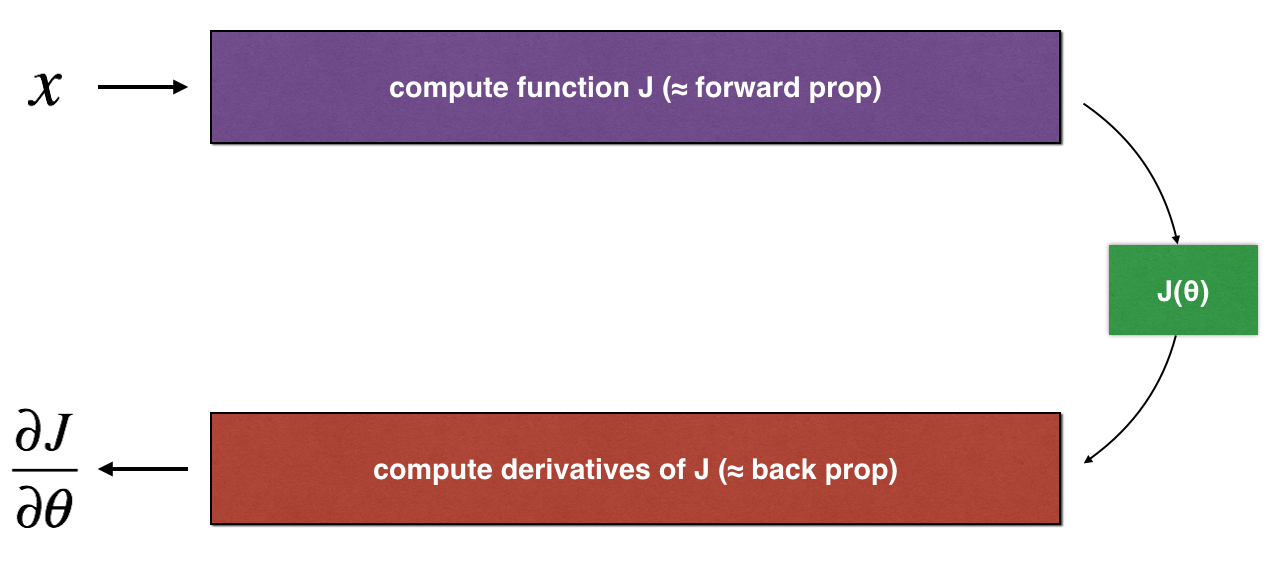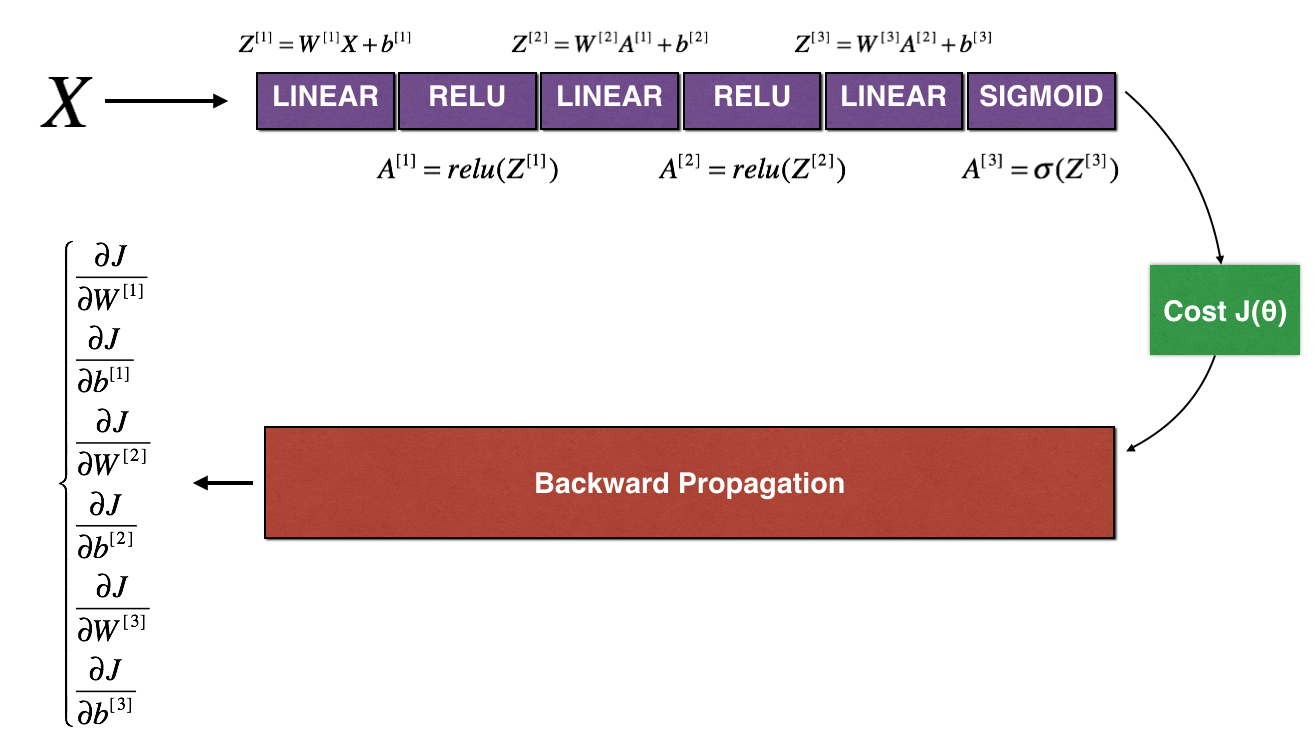改善深层神经网络-week1编程题(GradientChecking)
1. Gradient Checking
你被要求搭建一个Deep Learning model来检测欺诈,每当有人付款,你想知道是否该支付可能是欺诈,例如该用户的账户可能已经被黑客掉。
但是,反向传播实现起来非常有挑战,并且有时有一些bug,因为这是一个mission-critical应用,你公司老板想让十分确定,你实现的反向传播是正确的。你需要用“gradient checking”来证明你的反向传播是正确的。
# Packagesimport numpy as npfrom testCases import *from gc_utils import sigmoid, relu, dictionary_to_vector, vector_to_dictionary, gradients_to_vector
1.1 gradient checking 如何工作?
Backpropagation 计算梯度(the gradients) \(\frac{\partial J}{\partial \theta}\), \(\theta\)代表着模型的参数,\(J\) 是使用前向传播和你的loss function来计算的。
前向传播十分容易,因此你使用计算 \(J\) 的代码 来确认计算 \(\frac{\partial J}{\partial \theta}\) 的代码
我们来看一下derivative (or gradient)的定义:
\]
接下来:
- \(\frac{\partial J}{\partial \theta}\) 是你想要确保计算正确的
- 你可以计算\(J(\theta + \varepsilon)\) and \(J(\theta - \varepsilon)\)(这个例子中\(\theta\)是一个实数)。(已知J是正确的)
我们要使用公式(1) 和一个很小的数 \(\varepsilon\) 来保证你计算 \(\frac{\partial J}{\partial \theta}\) 的代码是正确的。
2. 1-dimensional gradient checking
只考虑一元线性函数 \(J(\theta) = \theta x\). The model contains only a single real-valued parameter \(\theta\), and takes \(x\) as input.
You will implement code to compute \(J(.)\) and its derivative \(\frac{\partial J}{\partial \theta}\). You will then use gradient checking to make sure your derivative computation for \(J\) is correct.

**Figure 1** : **1D linear model**
上图展示了关键的计算步骤: 首先开始于 \(x\), 随后评估 \(J(x)\) ("forward propagation"). 然后计算 the derivative \(\frac{\partial J}{\partial \theta}\) ("backward propagation").
Exercise: 实现这个简单函数的 "forward propagation" and "backward propagation" . I.e., 计算 \(J(.)\) ("forward propagation") 和 它关于 \(\theta\) 的导数("backward propagation"), 在两个函数里。
# GRADED FUNCTION: forward_propagationdef forward_propagation(x, theta):"""Implement the linear forward propagation (compute J) presented in Figure 1 (J(theta) = theta * x)Arguments:x -- a real-valued inputtheta -- our parameter, a real number as wellReturns:J -- the value of function J, computed using the formula J(theta) = theta * x"""### START CODE HERE ### (approx. 1 line)J = theta * x### END CODE HERE ###return J
测试:
x, theta = 2, 4J = forward_propagation(x, theta)print ("J = " + str(J))
J = 8
Exercise: 现在,实现图1中反向传播(导数计算)步骤:计算 \(J(\theta) = \theta x\) 关于 \(\theta\) 的导数. 用 \(dtheta = \frac { \partial J }{ \partial \theta} = x\) 来保存你做的计算。
# GRADED FUNCTION: backward_propagationdef backward_propagation(x, theta):"""Computes the derivative of J with respect to theta (see Figure 1).Arguments:x -- a real-valued inputtheta -- our parameter, a real number as wellReturns:dtheta -- the gradient of the cost with respect to theta"""### START CODE HERE ### (approx. 1 line)dtheta = x### END CODE HERE ###return dtheta
测试
x, theta = 2, 4dtheta = backward_propagation(x, theta)print ("dtheta = " + str(dtheta))
dtheta = 2
Exercise: 为了显示 backward_propagation() 函数是正确计算 the gradient \(\frac{\partial J}{\partial \theta}\), 让我们实现 gradient checking.
Instructions:
- 首先,计算 "gradapprox" 使用公式(1)和 一个很小的值 \(\varepsilon\).遵循以下步骤:
- \(\theta^{+} = \theta + \varepsilon\)
- \(\theta^{-} = \theta - \varepsilon\)
- \(J^{+} = J(\theta^{+})\)
- \(J^{-} = J(\theta^{-})\)
- \(gradapprox = \frac{J^{+} - J^{-}}{2 \varepsilon}\)
- 然后,使用backward propagation计算gradient , 并存储结果到变量 "grad"
- 最后, 计算 "gradapprox" 和 the "grad" 的相对偏差,使用下列公式:
\]
你需要三个步骤来计算这个公式:
- 1'. compute the numerator(分子) using np.linalg.norm(...)
- 2'. compute the denominator(分母). You will need to call np.linalg.norm(...) twice.
- 3'. divide them.
- 如果这个 difference 非常小 (小于 \(10^{-7}\)), gradient计算正确. 否则,错误.
# GRADED FUNCTION: gradient_checkdef gradient_check(x, theta, epsilon = 1e-7):"""Implement the backward propagation presented in Figure 1.Arguments:x -- a real-valued inputtheta -- our parameter, a real number as wellepsilon -- tiny shift to the input to compute approximated gradient with formula(1)Returns:difference -- difference (2) between the approximated gradient and the backward propagation gradient"""# Compute gradapprox using left side of formula (1). epsilon is small enough, you don't need to worry about the limit.### START CODE HERE ### (approx. 5 lines)thetaplus = theta + epsilonthetaminus = theta - epsilonJ_plus = forward_propagation(x, thetaplus)J_minus = forward_propagation(x, thetaminus)gradapprox = (J_plus - J_minus) / (2. * epsilon)### END CODE HERE #### Check if gradapprox is close enough to the output of backward_propagation()### START CODE HERE ### (approx. 1 line)grad = backward_propagation(x, theta)### END CODE HERE ###### START CODE HERE ### (approx. 1 line)numerator = np.linalg.norm(grad - gradapprox)denominator = np.linalg.norm(grad) + np.linalg.norm(gradapprox)difference = numerator / denominator### END CODE HERE ###if difference < 1e-7:print ("The gradient is correct!")else:print ("The gradient is wrong!")return difference
x, theta = 2, 4difference = gradient_check(x, theta)print("difference = " + str(difference))
The gradient is correct!
difference = 2.919335883291695e-10
上述计算检验正确。即,可以正确的计算反向传播。
现在,你的 cost function \(J\) has more than a single 1D input。当你训练一个神经网络,\(\theta\) 事实上由multiple matrices \(W^{[l]}\) and biases \(b^{[l]}\)组成,知道如何 梯度检验 高维度输入 非常重要。
3. N-dimensional gradient checking
下图描述了你的欺诈检测的前向和反向传播的模型:

**Figure 2** : **deep neural network**
*LINEAR -> RELU -> LINEAR -> RELU -> LINEAR -> SIGMOID*
下面实现forward propagation and backward propagation.
def forward_propagation_n(X, Y, parameters):"""Implements the forward propagation (and computes the cost) presented in Figure 3.Arguments:X -- training set for m examplesY -- labels for m examplesparameters -- python dictionary containing your parameters "W1", "b1", "W2", "b2", "W3", "b3":W1 -- weight matrix of shape (5, 4)b1 -- bias vector of shape (5, 1)W2 -- weight matrix of shape (3, 5)b2 -- bias vector of shape (3, 1)W3 -- weight matrix of shape (1, 3)b3 -- bias vector of shape (1, 1)Returns:cost -- the cost function (logistic cost for one example)"""# retrieve parametersm = X.shape[1]W1 = parameters["W1"]b1 = parameters["b1"]W2 = parameters["W2"]b2 = parameters["b2"]W3 = parameters["W3"]b3 = parameters["b3"]# LINEAR -> RELU -> LINEAR -> RELU -> LINEAR -> SIGMOIDZ1 = np.dot(W1, X) + b1A1 = relu(Z1)Z2 = np.dot(W2, A1) + b2A2 = relu(Z2)Z3 = np.dot(W3, A2) + b3A3 = sigmoid(Z3)# Costlogprobs = np.multiply(-np.log(A3),Y) + np.multiply(-np.log(1 - A3), 1 - Y)cost = 1./m * np.sum(logprobs)cache = (Z1, A1, W1, b1, Z2, A2, W2, b2, Z3, A3, W3, b3)return cost, cache
Now, run backward propagation.
def backward_propagation_n(X, Y, cache):"""Implement the backward propagation presented in figure 2.Arguments:X -- input datapoint, of shape (input size, 1)Y -- true "label"cache -- cache output from forward_propagation_n()Returns:gradients -- A dictionary with the gradients of the cost with respect to each parameter, activation and pre-activation variables."""m = X.shape[1](Z1, A1, W1, b1, Z2, A2, W2, b2, Z3, A3, W3, b3) = cachedZ3 = A3 - YdW3 = 1./m * np.dot(dZ3, A2.T)db3 = 1./m * np.sum(dZ3, axis=1, keepdims=True)dA2 = np.dot(W3.T, dZ3)dZ2 = np.multiply(dA2, np.int64(A2 > 0))dW2 = 1./m * np.dot(dZ2, A1.T) * 2 # 这里故意写错db2 = 1./m * np.sum(dZ2, axis=1, keepdims = True)dA1 = np.dot(W2.T, dZ2)dZ1 = np.multiply(dA1, np.int64(A1 > 0))dW1 = 1./m * np.dot(dZ1, X.T)db1 = 4./m * np.sum(dZ1, axis=1, keepdims = True) # 这里故意写错gradients = {"dZ3": dZ3, "dW3": dW3, "db3": db3,"dA2": dA2, "dZ2": dZ2, "dW2": dW2, "db2": db2,"dA1": dA1, "dZ1": dZ1, "dW1": dW1, "db1": db1}return gradients
下面进行梯度检验来确保你的梯度是正确的.
gradient checking 如何工作?.
As in 1) and 2), you want to compare "gradapprox" to the gradient computed by backpropagation. The formula is still:
\]
但是, \(\theta\) 不再是标量. 而是一个叫 "parameters"的字典. 下面实现一个 "dictionary_to_vector()"(字典转向量). 它将"parameters" dictionary 转换成名为"values"的vector, 通过 reshaping all parameters (W1, b1, W2, b2, W3, b3) into vectors and concatenating(连接) them 获得.
The inverse function is "vector_to_dictionary"(向量转字典) which outputs back the "parameters" dictionary.

**Figure 2** : **dictionary_to_vector() and vector_to_dictionary()**
You will need these functions in gradient_check_n()
We have also converted the "gradients" dictionary into a vector "grad" using gradients_to_vector(). You don't need to worry about that.
Exercise: Implement gradient_check_n().
Instructions: 这里的伪代码(pseudo-code)将帮助你实现梯度检测(the gradient check).
For each i in num_parameters:
- To compute
J_plus[i]:- Set \(\theta^{+}\) to
np.copy(parameters_values)(深拷贝) - Set \(\theta^{+}_i\) to \(\theta^{+}_i + \varepsilon\)
- Calculate \(J^{+}_i\) using to
forward_propagation_n(x, y, vector_to_dictionary(\(\theta^{+}\))).
- Set \(\theta^{+}\) to
- To compute
J_minus[i]: do the same thing with \(\theta^{-}\) - Compute \(gradapprox[i] = \frac{J^{+}_i - J^{-}_i}{2 \varepsilon}\)
Thus, you get a vector gradapprox, where gradapprox[i] is an approximation of the gradient with respect to parameter_values[i]. You can now compare this gradapprox vector to the gradients vector from backpropagation. Just like for the 1D case (Steps 1', 2', 3'), compute:
\]
# GRADED FUNCTION: gradient_check_ndef gradient_check_n(parameters, gradients, X, Y, epsilon = 1e-7):"""Checks if backward_propagation_n computes correctly the gradient of the cost output by forward_propagation_nArguments:parameters -- python dictionary containing your parameters "W1", "b1", "W2", "b2", "W3", "b3":grad -- output of backward_propagation_n, contains gradients of the cost with respect to the parameters.x -- input datapoint, of shape (input size, 1)y -- true "label"epsilon -- tiny shift to the input to compute approximated gradient with formula(1)Returns:difference -- difference (2) between the approximated gradient and the backward propagation gradient"""# Set-up variables# print(parameters)parameters_values, _ = dictionary_to_vector(parameters) # 将字典转换成向量# print(parameters_values, i) # (W1, b1, W2, b2, .....) (注:此处W1,b1都转换成了向量)grad = gradients_to_vector(gradients) # 梯度转换成向量num_parameters = parameters_values.shape[0] # 所有参数个数J_plus = np.zeros((num_parameters, 1)) # 初始化为 (num, 1)的向量J_minus = np.zeros((num_parameters, 1))gradapprox = np.zeros((num_parameters, 1))# Compute gradapproxfor i in range(num_parameters): # 遍历所有参数,每个参数都求一遍 gradapprox,很费时间# Compute J_plus[i]. Inputs: "parameters_values, epsilon". Output = "J_plus[i]".# "_" is used because the function you have to outputs two parameters but we only care about the first one### START CODE HERE ### (approx. 3 lines)thetaplus = np.copy(parameters_values)thetaplus[i, 0] += epsilon# Step 2J_plus[i], _ = forward_propagation_n(X, Y, vector_to_dictionary(thetaplus)) # Step 3### END CODE HERE #### Compute J_minus[i]. Inputs: "parameters_values, epsilon". Output = "J_minus[i]".### START CODE HERE ### (approx. 3 lines)thetaminus = np.copy(parameters_values) # Step 1thetaminus[i, 0] -= epsilon # Step 2J_minus[i], _ = forward_propagation_n(X, Y, vector_to_dictionary(thetaminus)) # Step 3### END CODE HERE #### Compute gradapprox[i]### START CODE HERE ### (approx. 1 line)gradapprox[i] = (J_plus[i] - J_minus[i]) / (2. * epsilon)### END CODE HERE #### Compare gradapprox to backward propagation gradients by computing difference.### START CODE HERE ### (approx. 1 line)numerator = np.linalg.norm(grad - gradapprox) # Step 1'denominator = np.linalg.norm(grad) + np.linalg.norm(gradapprox) # Step 2'difference = numerator / denominatorif difference > 1.2e-7:print ("\033[93m" + "There is a mistake in the backward propagation! difference = " + str(difference) + "\033[0m")else:print ("\033[92m" + "Your backward propagation works perfectly fine! difference = " + str(difference) + "\033[0m")return difference
X, Y, parameters = gradient_check_n_test_case()cost, cache = forward_propagation_n(X, Y, parameters)gradients = backward_propagation_n(X, Y, cache)difference = gradient_check_n(parameters, gradients, X, Y)
There is a mistake in the backward propagation! difference = 0.2850931566540251
可以看出,在 backward_propagation_n代码中有一些错误。
现在,我们修复这个错误,再来运行一下上面代码:
dA2 = np.dot(W3.T, dZ3)dZ2 = np.multiply(dA2, np.int64(A2 > 0))# dW2 = 1./m * np.dot(dZ2, A1.T) * 2 # 这里故意写错dW2 = 1./m * np.dot(dZ2, A1.T) # 修复db2 = 1./m * np.sum(dZ2, axis=1, keepdims = True)dA1 = np.dot(W2.T, dZ2)dZ1 = np.multiply(dA1, np.int64(A1 > 0))dW1 = 1./m * np.dot(dZ1, X.T)# db1 = 4./m * np.sum(dZ1, axis=1, keepdims = True) # 这里故意写错db1 = 1./m * np.sum(dZ1, axis=1, keepdims = True) # 修复
重新运行 backward_propagation_n()
输出:
Your backward propagation works perfectly fine! difference = 1.1885552035482147e-07
Note
- Gradient Checking is slow! Approximating the gradient with \(\frac{\partial J}{\partial \theta} \approx \frac{J(\theta + \varepsilon) - J(\theta - \varepsilon)}{2 \varepsilon}\) 计算非常耗时. 因此, 我们在训练集上不是每一次迭代都运行梯度检测. 仅几次验证梯度是否正确,然后关掉它。
- Gradient Checking, 不能和dropout一起工作. 你可以关掉 dropout 再运行 the gradient check algorithm 来确保你的 backprop 是正确的, 然后再打开dropout.
改善深层神经网络-week1编程题(GradientChecking)的更多相关文章
- 改善深层神经网络-week1编程题(Initializaion)
Initialization 如何选择初始化方式,不同的初始化会导致不同的结果 好的初始化方式: 加速梯度下降的收敛(Speed up the convergence of gradient desc ...
- 改善深层神经网络-week1编程题(Regularization)
Regularization Deep Learning models have so much flexibility and capacity that overfitting can be a ...
- 改善深层神经网络-week2编程题(Optimization Methods)
1. Optimization Methods Gradient descent goes "downhill" on a cost function \(J\). Think o ...
- 改善深层神经网络-week3编程题(Tensorflow 实现手势识别 )
TensorFlow Tutorial Initialize variables Start your own session Train algorithms Implement a Neural ...
- deeplearning.ai 改善深层神经网络 week1 深度学习的实用层面 听课笔记
1. 应用机器学习是高度依赖迭代尝试的,不要指望一蹴而就,必须不断调参数看结果,根据结果再继续调参数. 2. 数据集分成训练集(training set).验证集(validation/develop ...
- deeplearning.ai 改善深层神经网络 week1 深度学习的实用层面
1. 应用机器学习是高度依赖迭代尝试的,不要指望一蹴而就,必须不断调参数看结果,根据结果再继续调参数. 2. 数据集分成训练集(training set).验证集(validation/develop ...
- 改善深层神经网络_优化算法_mini-batch梯度下降、指数加权平均、动量梯度下降、RMSprop、Adam优化、学习率衰减
1.mini-batch梯度下降 在前面学习向量化时,知道了可以将训练样本横向堆叠,形成一个输入矩阵和对应的输出矩阵: 当数据量不是太大时,这样做当然会充分利用向量化的优点,一次训练中就可以将所有训练 ...
- [DeeplearningAI笔记]改善深层神经网络_深度学习的实用层面1.10_1.12/梯度消失/梯度爆炸/权重初始化
觉得有用的话,欢迎一起讨论相互学习~Follow Me 1.10 梯度消失和梯度爆炸 当训练神经网络,尤其是深度神经网络时,经常会出现的问题是梯度消失或者梯度爆炸,也就是说当你训练深度网络时,导数或坡 ...
- deeplearning.ai 改善深层神经网络 week3 超参数调试、Batch正则化和程序框架 听课笔记
这一周的主体是调参. 1. 超参数:No. 1最重要,No. 2其次,No. 3其次次. No. 1学习率α:最重要的参数.在log取值空间随机采样.例如取值范围是[0.001, 1],r = -4* ...
随机推荐
- Shiro02
Shiro认证 Pom依赖 <dependency> <groupId>org.apache.shiro</groupId> <artifactId>s ...
- noip模拟18
\(\color{white}{\mathbb{曲径通幽,星汉隐约,缥缈灯影,朦胧缺月,名之以:薄雾}}\) 放眼望去前十被我弃掉的 \(t2\) 基本都上85了-- 开考就以为 \(t2\) 是个大 ...
- 自己实现一个Controller——精简型
写在最前 controller-manager作为K8S master的其中一个组件,负责众多controller的启动和终止,这些controller负责监控着k8s中各种资源,执行调谐,使他们的实 ...
- CentOS8部署tftp
tftp:简单文本传输协议,而ftp:文本传输协议.可以把tftp看成是ftp的精简版.tftp用于免登录传输小文件,tftp服务端监听在udp协议的69端口tftp简单的工作原理: tftp服务端与 ...
- Jmeter系列(1) - 踩坑之代理服务器录制失败
前景 Jmeter代理服务器报错信息如下.Jmeter录制不成功 解决方案 需了解 代理服务器启动后会在/bin目录生成ApacheJMeterTemporaryRootCA.crt和ApacheJM ...
- JDK1.8源码(四)——java.util.Arrays类
一.概述 1.介绍 Arrays 类是 JDK1.2 提供的一个工具类,提供处理数组的各种方法,基本上都是静态方法,能直接通过类名Arrays调用. 二.类源码 1.asList()方法 将一个泛型数 ...
- 远程连接centos7中mysql8.0
远程连接centos7中mysql8.0 1.使用Navicat for MySQL或者其它数据连接软件 2.先检查centos中防火墙是否关闭,如果关闭不需要设置,如果没有关闭防火墙,请打开3306 ...
- ❤️❤️爆肝3万字整理小白快速入门分布式版本管理软件:Git,图文并茂(建议收藏)--已码一万字❤️❤️
@ 目录 什么是Git SVN VS Git 什么是版本控制 安装Git 谁在操作? Git本地仓库 本地仓库构造 重点 Git基本操作 git add git commit git diff git ...
- 好久没发文了,一篇Vue3的Composition API使用奉上
Composition API Composition API是Vue3中推荐的组件代码书写方式,相较于传统的Options API来说,它能让业务逻辑处理和后期代码维护变的更加简单. 首先我们来看O ...
- Oracle部署迁移手册
第1章 安装准备 1.1 安装环境 操作系统:Redhat6.5 x64 32核CPU 62G内存 系统盘300G 数据磁盘3T Oracle软件:Oracle Database 11g Enterp ...
